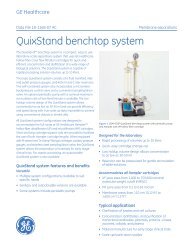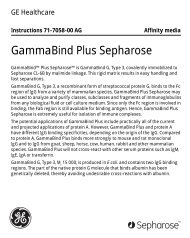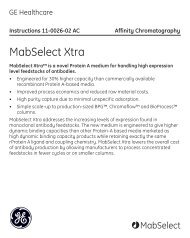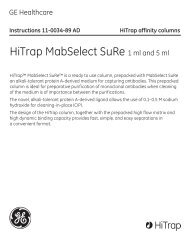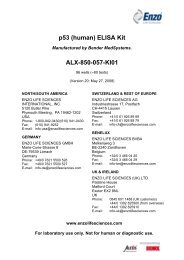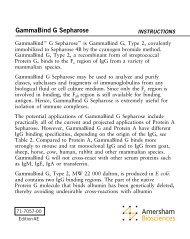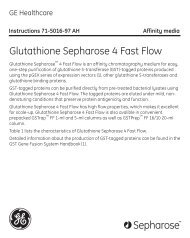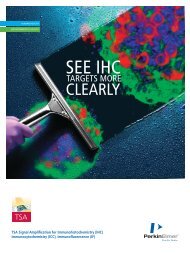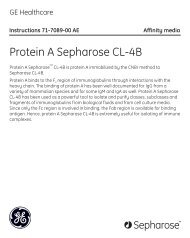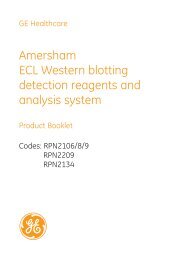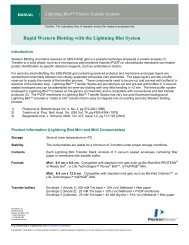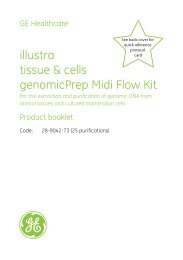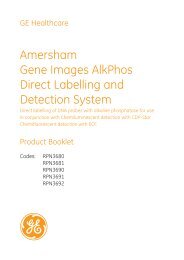Protein A HP MultiTrap - GE Healthcare Life Sciences
Protein A HP MultiTrap - GE Healthcare Life Sciences
Protein A HP MultiTrap - GE Healthcare Life Sciences
You also want an ePaper? Increase the reach of your titles
YUMPU automatically turns print PDFs into web optimized ePapers that Google loves.
<strong>GE</strong> <strong>Healthcare</strong>Instructions 28-9067-71 AC <strong>Protein</strong> Sample Preparation<strong>Protein</strong> A <strong>HP</strong> <strong>MultiTrap</strong><strong>Protein</strong> A <strong>HP</strong> <strong>MultiTrap</strong> contains• 4 prepacked <strong>Protein</strong> A <strong>HP</strong> <strong>MultiTrap</strong> 96-well filter plates• Instructions for useIntroduction<strong>Protein</strong> A <strong>HP</strong> <strong>MultiTrap</strong> is designed for small-scale samplepreparation for single use, for example upstream of gelelectrophoresis, liquid chromatography and mass spectrometry.<strong>MultiTrap</strong> may be used with robotic systems or manually, withcentrifugation or vacuum.The plate wells contain <strong>Protein</strong> A Sepharose High Performancecolumns. The plates are designed for two different applications:• Enrichment of target proteins• Purification of antibodiesThe current instructions provide background information,protocols, and general useful information for both applications.1. General handling of the <strong>MultiTrap</strong> plate• Centrifugation/vacuum: Centrifuge the <strong>MultiTrap</strong> plates or usevacuum. If vacuum is used, apply 0.15 bar until the wells areempty, then slowly increase the vacuum to -0.3 bar (do not applymore vacuum than -0.5 bar). Turn off the vacuum afterapproximately 5 sec.• Medium: Mix briefly before removal of liquid in the equilibration,wash and elution steps to increase the efficiency of the step.Incubating on a plate shaker is recommended.• Incubations: During incubation, cover the plate using a sealingtape or an appropriate 96-well cover.• Collection plates: Collection plates are not included and mustbe ordered separately (see Section 5). Remember to change orempty the collection plate between steps.• Sample pretreatment: Excessive cellular debris and lipids mayclog the column. Clarify the sample by centrifugation or filtrationbefore applying to the <strong>MultiTrap</strong> plate <strong>MultiTrap</strong> plate well.• Sample pre-treatment: To prevent target protein degradation,inhibition of protease activity may be required (a ProteaseInhibitor Mix is available, see Section 5.Content1. General handling of the <strong>MultiTrap</strong> plate - - - - - - - - - - - - 12. Antibody purification - - - - - - - - - - - - - - - - - - - - - 22.1 Purpose - - - - - - - - - - - - - - - - - - - - - - - - - - - 22.2 Principle - - - - - - - - - - - - - - - - - - - - - - - - - - - 22.3 Advice on handling - - - - - - - - - - - - - - - - - - - - - - 22.4 Antibody binding to protein A and protein G - - - - - - - - - 22.5 Antibody purification protocol - - - - - - - - - - - - - - - - 33. <strong>Protein</strong> enrichment - - - - - - - - - - - - - - - - - - - - - - 43.1 Purpose - - - - - - - - - - - - - - - - - - - - - - - - - - - 43.2 Principle - - - - - - - - - - - - - - - - - - - - - - - - - - - 43.3 Advice on handling - - - - - - - - - - - - - - - - - - - - - - 43.4 Cross-link protocol - - - - - - - - - - - - - - - - - - - - - - 53.5 Classic protocol - - - - - - - - - - - - - - - - - - - - - - - 64. Characteristics - - - - - - - - - - - - - - - - - - - - - - - - 75. Ordering information - - - - - - - - - - - - - - - - - - - - - 7
Instructions 28-9067-71 AC2. Antibody purification2.1 PurposeThe <strong>Protein</strong> A <strong>HP</strong> <strong>MultiTrap</strong> 96-well plates are designed for rapidsmall-scale antibody purification of multiple samples in parallel, forexample in antibody screening experiments.2.2 Principle<strong>Protein</strong> A Sepharose <strong>HP</strong> has a high protein binding capacity and iscompatible with all buffers commonly used in antibody purification.The <strong>MultiTrap</strong> can be used with a standard centrifuge and onepurification takes less than 20 minutes. Cell culture supernatants, aswell as serum samples, may be directly applied to the wells withoutprior clarification.2.3 Advice on handlingOptimization of parametersThe parameters for antibody purification may require optimization.Examples of parameters which may require optimization are:• sample pretreatment• amount of antibody to be purified• incubation time• choice of buffers• number of washesSample pretreatmentAntibodies from several species can be purified with <strong>Protein</strong> ASepharose High Performance.IgG from many species has a medium to strong affinity for <strong>Protein</strong> Aat approximately pH 7.0, see Section 2.4.The sample should have a pH around 7 before applying to a well. It istherefore important to check the pH of the sample, and adjust it asnecessary before applying the sample to the well.Choice of buffersThe following buffers are recommended.Binding buffer: 20 mM sodium phosphate, pH 7.0Elution buffer: 0.1 M glycine-HCl, pH 2.7Neutralizing buffer: 1 M Tris-HCl, pH 9.0Note: Use high-purity water and chemicals for buffer preparation.• Recommended buffers can be easily prepared using Ab BufferKit, see Section 5.• <strong>Protein</strong> A Sepharose High Performance binds IgG over a wide pHrange with a strong affinity at neutral pH. To elute the IgG, it isnecessary to lower the pH to about 2.5 to 3.0 depending on theantibody.• As a safety measure to preserve the activity of acid-labile IgGs,we recommend the addition of 1 M Tris-HCl, pH 9.0, to collectionplate used for collecting IgG-containing fractions (60 to200 µl/ml eluted fraction). In this way, the final pH of the samplewill be approximately neutral.<strong>Protein</strong> Sample PreparationAntibody recovery• If the pH of the sample is too low the antibody may have lowbinding to <strong>Protein</strong> A Sepharose High Performance matrix. Ensurethat the pH is approximately 7.• If the <strong>MultiTrap</strong> wells does not have enough capacity for theamount of antibody in the sample the recovery will be less thanexpected. Decrease the amount of sample added to each well.2.4 Antibody binding to <strong>Protein</strong> A and protein GRelative binding strengths for protein A and protein GSpecies Subclass <strong>Protein</strong> A binding <strong>Protein</strong> G bindingHuman IgA variable -IgD - -IgD - -IgG 1 ++++ ++++IgG 2 ++++ ++++IgG 3 - ++++IgG 4 ++++ ++++IgM variable -Avian egg yolk IgY - -Cow ++ ++++Dog ++ +Goat - ++Guinea pig IgG 1 ++++ ++IgG 2 ++++ ++Hamster + ++Horse ++ ++++Koala - +Llama - +Monkey (rhesus) ++++ ++++Mouse IgG 1 + ++++IgG 2a ++++ ++++IgG 2b +++ +++IgG 3 ++ +++IgM variable -Pig +++ +++Rabbit ++++ +++Rat IgG 1 - +IgG 2a - ++++IgG 2b - ++IgG 3 - ++Sheep +/- ++++++ = strong binding++ = medium binding- = weak or no binding2
Instructions 28-9067-71 AC<strong>Protein</strong> Sample Preparation2.5 Antibody purification protocolThe protocol may need optimization for your application, see Section 2.3. Please refer to Section 1 for general handling instructions.1 Prepare collection plates• For step 6, prepare 2 collection plates for eluted fractions, eachcontaining 15 µl neutralizing buffer per well.2 Remove storage solution• Suspend the medium by gently shaking the plate upside down.• Remove top and bottom seals and place the <strong>MultiTrap</strong> plate on acollection plate.• Remove the storage solution by centrifugation for 1 min at70-100 × g.3 Equilibrate• Add 300 µl binding buffer and mix briefly.• Centrifuge for 30 s at 70-100 × g.4 Bind antibody• Add maximum 300 µl of the antibody solution.• Incubate for 4 min while gently mixing.• Centrifuge for 30 s at 70-100 × g.Note:Several sample applications can be made subsequently as long as thecapacity of the column is not exceeded.5 Wash• Add 300 µl binding buffer, mix briefly and centrifuge for 30 s at70-100 × g.• Perform this step 2 times total.6 Elute antibody• Replace the collection plate with a collection plate prepared in step 1.• Add 200 µl of elution buffer, mix briefly and centrifuge for 30 s at70 × g and collect the eluate.• Perform this procedure 2 times total.Note: Most of the bound antibody is eluted after two elution steps.1. Remove storage solutionShake gently upside downRemove the seals1 min700 × g2. Equilibration Add 300 µlbinding buffer30 s70-100 × g3. Capture of affinity moleculeAdd 300 µl antibodyin binding bufferIncubate 4 minon shaker30 s70-100 × g2. Equilibration Add 300 µlbinding buffer2 x30 s70-100 × g2. Equilibration Add 200 µlbinding buffer2 x30 s70 × g3
Instructions 28-9067-71 AC3. <strong>Protein</strong> enrichment3.1 PurposeThe <strong>Protein</strong> A <strong>HP</strong> <strong>MultiTrap</strong> prepacked 96-well plates are designed forsmall-scale protein enrichment for single use, for example for useupstream of gel electrophoresis, liquid chromatography, and massspectrometry.3.2 PrincipleThere are two protocols for protein enrichment using <strong>Protein</strong> A <strong>HP</strong><strong>MultiTrap</strong> prepacked 96-well plates:Cross-link protocolIn the cross-link protocol the protein capturing antibodies arecovalently bound to the <strong>Protein</strong> G Sepharose High Performancematrix by using a cross-linking agent.The protein of interest is enriched from the sample, purified throughwashings, and eluted from the wells whereas the antibody remainsbound to the matrix.Use the cross-link protocol:• If the desired protein/antigen has similar molecular weight asthe heavy or light chain of the antibody, which causes problemwith comigration in SDS-PA<strong>GE</strong> analysis.• If the antibody interferes with downstream analysis.Classic protocolIn the classic protocol protein capturing antibodies are immobilizedby binding to <strong>Protein</strong> A in the <strong>Protein</strong> A Sepharose High Performancematrix. The classic protocol requires that the capturing antibody usedbinds to <strong>Protein</strong> A.The protein/antigen of interest is enriched from the sample, purifiedthrough washings and eluted from the wells together with theantibody.3.3 Advice on handlingOptimization of parametersThe optimal parameters for protein enrichment are dependent on thespecific antibody-antigen combination. Optimization may berequired for each specific antibody-antigen combination to obtainthe best results.Examples of parameters which may require optimization are:• Sample pre-treatment• Amount of protein (antigen) to be enriched• Incubation time• Choice of buffers• Number of washesSample pretreatment• Excessive cellular debris and lipids may clog the well. Clarify thesample by centrifugation or filtration before applying to the<strong>MultiTrap</strong> wells.• To prevent target protein degradation, inhibition of proteaseactivity may be required (a Protease Inhibitor Mix is available,see Section 5.Incubation timeAt room temperature, the reaction is usually completed within 30 to60 min. If the binding is performed at 4°C, it can be left overnight.Choice of buffers<strong>Protein</strong> Sample PreparationIt is recommended to use the listed buffers for the indicated type ofprotocol. A <strong>Protein</strong> A/G Buffer Kit is available as an accessory forincreased convenience. If optimization is required try to use thealternative buffers.Cross-link protocolBinding buffer: TBS (50 mM Tris, 150 mM NaCl, pH 7.5)Wash buffer: TBS with 2 M urea, pH 7.5Elution buffer: 0.1 M glycine with 2 M urea, pH 2.9Cross-link solutions: • 200 mM triethanolamine, pH 8.9• 50 mM DMP (Dimethyl pimelimidatedihydrochloride) in 200 mMtriethanolamine, pH 8.9• 100 mM ethanolamine, pH 8.9Classic protocolBinding buffer: TBS (50 mM Tris, 150 mM NaCl, pH 7.5)Wash buffer:TBSElution buffer:2.5% acetic acidAlternative buffersWash buffers: • TBS (mild wash)• TBS with 1% octylglucoside, pH 7.5• 0.1 M triethanolamine, 0.5 M NaCl,pH 9.0Elution buffers: • 0.1 M glycine, pH 2.5 to 3.1• 0.1 M citric acid, pH 2.5 to 3.1• 2% SDS• 0.1 M ammonium hydroxide,pH 10 to 11<strong>Protein</strong> recovery and specific purity• Improve the specific purity by adding detergent, different salts,and different concentrations of salts to the wash buffer.• Avoid acidic elution conditions since this may cause low proteinyield.• Minimize impurities that may co-elute with the target protein byadding a preclearing step before the enrichment procedure.For preclearing, use a <strong>MultiTrap</strong> well that has not been coupledwith an antibody. Add the sample and incubate for 0.5 to 4 h.Collect the sample by centrifugation and proceed with thestandard protocol using the coupled medium.• Try alternative buffers, see Section “Choice of buffers”.Additional options when using the classic protocol• Incubate the antibody with the sample to form an antibodyantigencomplex before applying the sample to the well. Thecomplex is then applied to the well for binding.4
Instructions 28-9067-71 AC<strong>Protein</strong> Sample Preparation3.4 Cross-link protocolThe protocol may need optimization for your application, see Section 3.3. Please refer to Section 1 for general handling instructions.1 Remove storage solution• Suspend the medium by gently shaking the plate upside down.• Remove top and bottom seals and place on a collection plate.• Remove the storage solution by centrifugation for 1 min at 700 x g.2 Equilibrate• Add 400 µl binding buffer, mix briefly and centrifuge for 1 min at 700 × g toequilibrate the medium.• Perform this step 3 times total.3 Bind antibody• Immediately after equilibration, add 200 µl of the antibody solution per well(0.5 to 1.0 mg/ml in binding buffer).• Incubate on shaker for 30 min.• Centrifuge for 1 min at 700 × g to remove unbound antibody.4 Wash• Add 400 µl binding buffer and mix briefly.• Centrifuge for 1 min at 700 × g.5 Change buffer• Add 400 µl triethanolamine and mix briefly.• Centrifuge for 1 min at 700 × g.6 Cross-link• Add 400 µl DMP in triethanolamine.• Incubate on shaker for 30 min for 60 min.• Centrifuge for 1 min at 700 × g.7 Wash• Add 400 µl triethanolamine and mix briefly.• Centrifuge for 1 min at 700 × g.8 Block• Add 400 µl ethanolamine• Incubate on shaker for 15 min.• Centrifuge for 1 min at 700 × g.9 Remove unbound antibody• Add 400 µl elution buffer and mix briefly.• Centrifuge for 1 min at 700 × g.10 Wash• Add 400 µl binding buffer, mix briefly and centrifuge for 1 min at 700 × g.• Perform this step 2 times total.11 Bind target protein• Add 200 µl of sample in binding buffer.• Incubate on shaker for 60 min.• Replace the collection plate with a clean collection plate• Centrifuge for 1 min at 700 × g to collection out unbound sample.• During optimization/trouble shooting: Collect flowthrough.12 Wash• Replace the collection plate with a clean collection plate• Add 400 µl collection buffer, mix briefly and centrifuge for 1 min at 700 × g.• Perform this step 5 times total.13 Elute• Collect the eluates in separate collection plates.• Add 200 µl of elution buffer, mix briefly and centrifuge for 1 min at 1000 × g.• Perform this step three 3 times total.ove storage solutionShake gently upside downRemove the seals1 min700 × guilibration Add 400 µlbinding buffer3 ×1 min700 × gure of affinity moleculenginge of affinity moleculegngnginge of affinity moleculengon2 ×2 ×5 ×3 ×Add 200 µl antibodyin binding bufferIncubate 30 minon shaker1 min700 × gAdd 400 µl binding buffer1 min700 × gAdd 400 µl triethanolamine1 min700 × gAdd 400 µl DMP intriethanolamineIncubate 60 minon shaker1 min700 × gAdd 400 µl triethanolamine1 min700 × gAdd 400 µl ethanolamineIncubate 15 minon shaker1 min700 × gAdd 400 µl elution buffer1 min700 × gAdd 400 µl binding buffer1 min700 × gAdd 200 µl samplein binding bufferIncubate 60 minon shaker1 min700 × gAdd 400 µl wash buffer1 min700 × gAdd 200 µl elution bufferShake for 1 min1 min1000 × g5
Instructions 28-9067-71 AC<strong>Protein</strong> Sample Preparation3.5 Classic protocolThe protocol may need optimization for your application, see Section 3.3. Please refer to Section 1 for general handling instructions.1 Remove storage solution• Suspend the medium by gently shaking the plate upside down.• Remove top and bottom seals and place the <strong>MultiTrap</strong> plate on acollection plate.• Remove the storage solution by centrifugation for 1 min at 700 x g.2 Equilibrate• Add 400 µl binding buffer per well, mix briefly and centrifuge for 1 minat 700 × g to equilibrate the medium.• Perform this step 3 times total.3 Bind antibody• Immediately after equilibration, add 200 µl of the antibody solutionper well (0.5 to 1.0 mg/ml in binding buffer).• Incubate on shaker for 30 min.• Centrifuge for 1 min at 700 × g to remove unbound antibody.4 Wash• Add 400 µl binding buffer per well, mix briefly.• Centrifuge for 1 min at 700 × g.5 Bind target protein• Add 200 µl sample in binding buffer per well.• Incubate on shaker for 60 min.• Replace the collection plate with a clean collection plate• Centrifuge for 1 min at 700 × g to wash out unbound sample.• During optimization/trouble shooting: Collect flowthrough.6 Wash• Replace the collection plate with a clean collection plate. Collect andsave washes in case troubleshooting is needed.• Add 400 µl wash buffer per well, mix briefly and centrifuge for 1 min at700 × g.• Perform this step 5 times total.7 Elute• Collect the eluates in separate collection plates.• Add 200 µl of desired elution buffer per well and shake for 1 min.• Centrifuge for 1 min at 700 x g.• Perform this procedure 3 times total.1. Remove storage solutionShake gently upside downRemove the seals1 min700 × g2. Equilibration Add 400 µlbinding buffer3 ×1 min700 × g3. Capture of affinity molecule5. Washing3. Capture of affinity molecule7. Washing5 ×Add 200 µl antibodyin binding bufferIncubate 30 minon shaker1 min700 × gAdd 400 µl binding buffer1 min700 × gAdd 200 µl samplein binding bufferIncubate 60 minon shaker1 min700 × gAdd 400 µl wash buffer1 min700 × g8. Elution Add 200 µl elution bufferShake for 1 min3 ×1 min700 × g6
Instructions 28-9067-71 AC<strong>Protein</strong> Sample PreparationO4. CharacteristicsMatrix Highly cross-linked agarose, 6%Medium<strong>Protein</strong> A Sepharose High PerformanceLigandNative protein ALigand coupling N-hydroxysuccinimide activationmethodLigand densityapprox. 3 mg protein A/ml mediumBinding capacity 1 approx. 20 mg human IgG/ml mediumAverage particle size 34 µmpH stability 23 to 9 (long term)2 to 9 (short term)Working temperature 4ºC to 30ºCStorage solution 20% ethanolStorage temp 4ºC to 8ºCFilter plate material Polypropylene and polyethyleneFilter plate size 3 127.8 x 85.5 x 30.6 mmVolume, prepacked 50 µlmedium/wellWell volume 800 µlCentrifugation speed 4 700 x gVacuum pressure 4• Recommended -0.1 to -0.3 bar• Maximum - 0.5 bar1<strong>Protein</strong> dependent2pH below 3 is sometimes required to elute strongly bound Ig species.However, protein ligands may hydrolyze at very low pH.3According to American Standard Institute (ANSI) and Society forBiomolecular Screening (SBS) standards 1-2004, 3-2004 and4-2004.4Actual settings will depend on the sample properties and pretreatment.5. Ordering informationProductsDescription Quantity Code No.<strong>Protein</strong> A <strong>HP</strong> <strong>MultiTrap</strong>4 x 96-well 28-9031-33filter platesRelated productsDescription Quantity Code No.Sample Grinding Kit 50 samples 80-6483-37Protease Inhibitor Mix 1 ml 80-6501-23Nuclease Mix 0.5 ml 80-6501-42NHS <strong>HP</strong> SpinTrap5 ml medium, 28-9031-2824 columnsStreptavidin <strong>HP</strong> SpinTrap 16 columns 28-9031-30Streptavidin <strong>HP</strong> <strong>MultiTrap</strong> 4 x 96-well 28-9031-31filter plates<strong>Protein</strong> A <strong>HP</strong> SpinTrap 16 columns 28-9031-32<strong>Protein</strong> G <strong>HP</strong> SpinTrap 16 columns 28-9031-34<strong>Protein</strong> G <strong>HP</strong> <strong>MultiTrap</strong>4 x 96-well 28-9031-35filter platesCollection Plate 5 x 96 well plates 28-4039-43Ab SpinTrap 50 x 100 µl 28-4083-47Ab Buffer Kit 1 28-9030-59<strong>Protein</strong> A/G SpinTrap buffer kit 1 28-9135-67LiteratureTitleCode No.Data File <strong>Protein</strong> A <strong>HP</strong> <strong>MultiTrap</strong> 28-9067-89Antibody Purification Handbook 18-1037-46Affinity Chromatography Handbook 18-1022-297
Instructions 28-9067-71 AC<strong>Protein</strong> Sample PreparationFor contact information for your local office,please visit: www.gelifesciences.com/contact<strong>GE</strong> <strong>Healthcare</strong> Bio-<strong>Sciences</strong> ABBjörkgatan 30751 84 UppsalaSwedenwww.gelifesciences.com/sampleprepwww.gelifesciences.com<strong>GE</strong>, imagination at work and <strong>GE</strong> monogram are trademarks of General Electric Company.Drop Design, <strong>MultiTrap</strong>, Sepharose, and SpinTrap are trademarks of <strong>GE</strong> <strong>Healthcare</strong> companies.© 2006-2008 General Electric Company – All rights reserved.First published November 2006.All goods and services are sold subject to the terms and conditions of sale of the company within <strong>GE</strong><strong>Healthcare</strong> which supplies them. A copy of these terms and conditions is available on request. Contactyour local <strong>GE</strong> <strong>Healthcare</strong> representative for the most current information.<strong>GE</strong> <strong>Healthcare</strong> Europe GmbHMunzinger Strasse 5, D-79111 Freiburg, Germany<strong>GE</strong> <strong>Healthcare</strong> UK LtdAmersham Place, Little Chalfont, Buckinghamshire, <strong>HP</strong>7 9NA, UK<strong>GE</strong> <strong>Healthcare</strong> Bio-<strong>Sciences</strong> Corp800 Centennial Avenue, P.O. Box 1327, Piscataway, NJ 08855-1327, USA<strong>GE</strong> <strong>Healthcare</strong> Bio-<strong>Sciences</strong> KKSanken Bldg. 3-25-1, Hyakunincho, Shinjuku-ku, Tokyo 169-0073, Japanimagination at work28-9067-71 AC 07/2008



